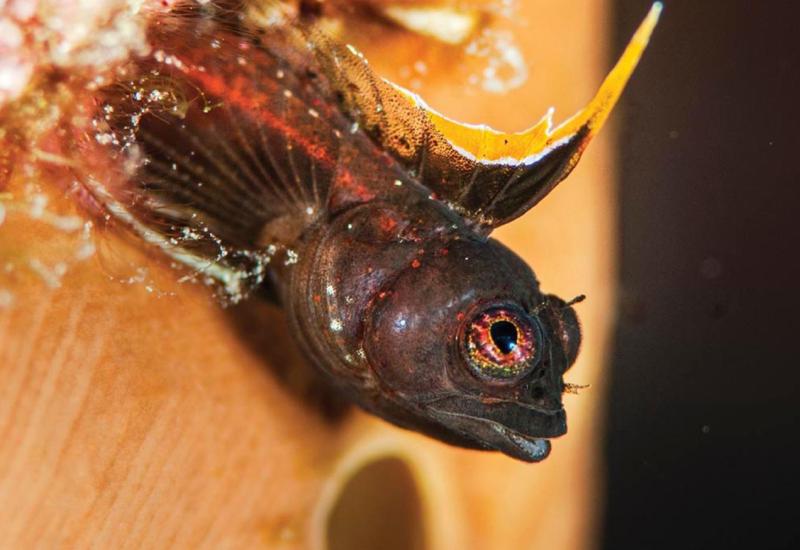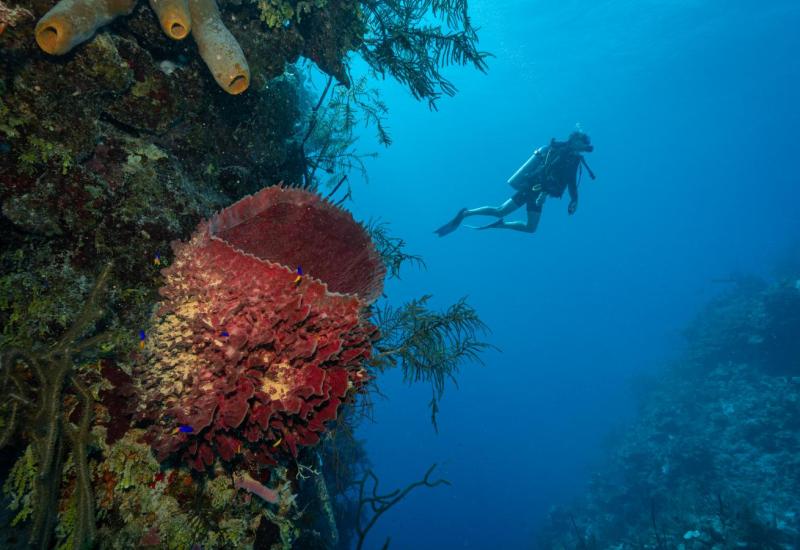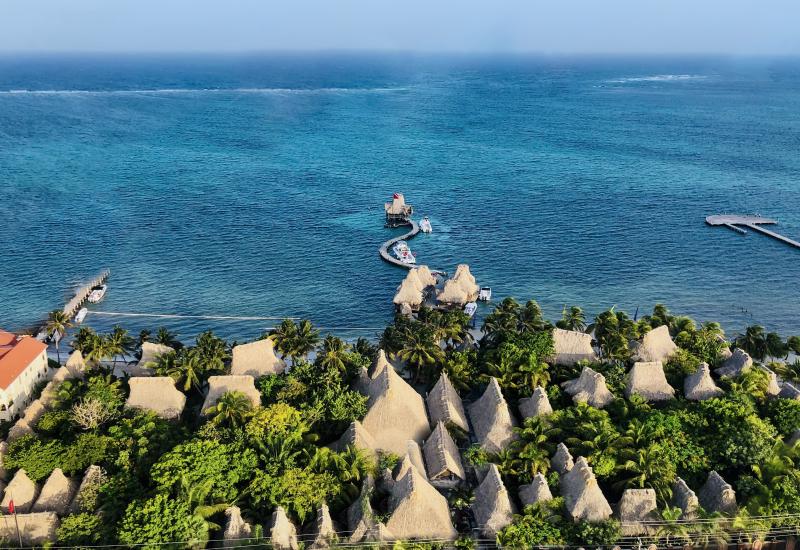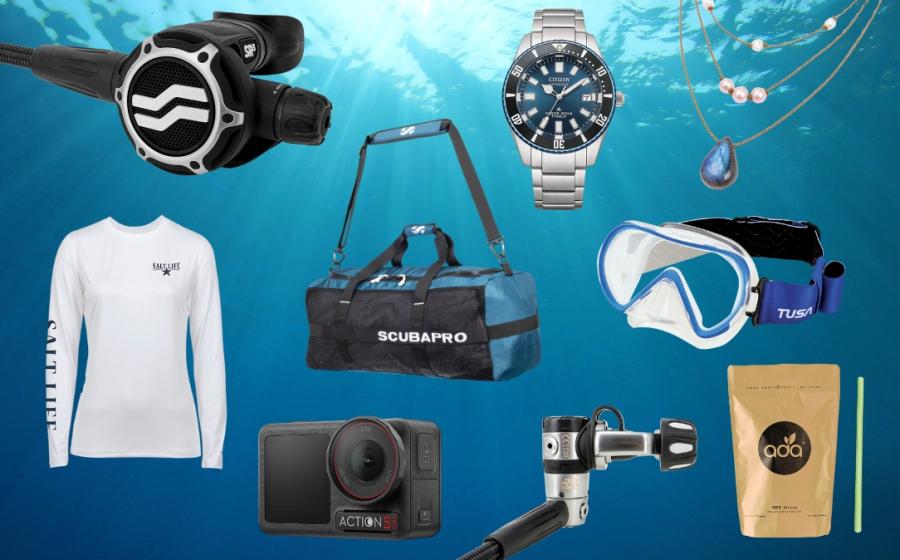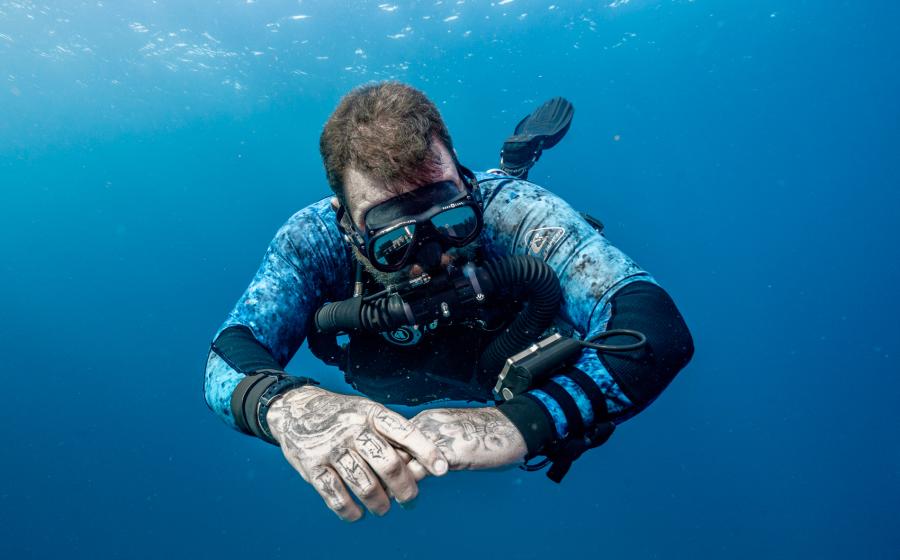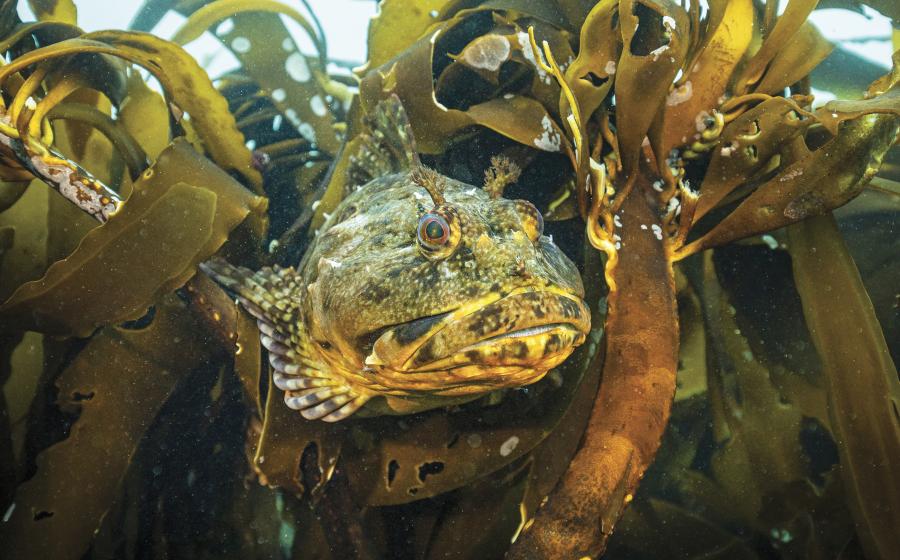As the Reef Turns
||
|---|
|  |
|
Ever-watchful, a secretary blenny guards its worm hole against potential poachers. Photography by Marli Wakeling.
January 2004
By Paul Kvinta
||||
|---|---|---|
|  |
|
| Like a soap-opera villain hiding in the shadows, a longlure frogfish lies in wait for unsuspecting prey. Photography by Ethan Gordon|
"Think of the reef here on Bonaire as one big Venezuelan soap opera," says naturalist Jerry Ligon, referring to the imported TV bodice-rippers that mesmerize the native women of this tiny Caribbean island every afternoon. "There's so much drama down there it's hard to keep it all straight." But Jerry is attempting to do just that, sorting out for me the reef's heartthrobs and its bullies, its backstabbing, its skulduggery, its moments of sweet redemption. And its sex. Lordy, Lordy, the sex! I'm taking Jerry's "Dive with a Naturalist" course, and Bonaire's preeminent reef expert is showing me computerized fish photos and providing lurid commentary. Consider: The blueheaded wrasse mates 20 times a day. Parrotfish females can become parrotfish males. Hell hath no fury like two homeless secretary blennies battling over an abandoned worm hole. And speaking of anger, the woefully misnamed damselfish will single-handedly and ferociously defend its turf against giant mobs of marauding fish. And on and on.
When my brain can't hold anymore, we suit up on the dock overlooking Bari Reef, one of the finest stages in the world to observe marine macro dramas. For one thing, Bari has more documented fish species (317) than any other single reef in the entire Caribbean, according to the Reef Environmental Education Foundation (REEF) database. For another, Bonaire's aquarium-like diving conditions--100-foot visibility, 85-degree water, almost no current--makes it possible to focus on the theatrics at hand. Also, like most of Bonaire's 86 designated dive sites, Bari is accessible from shore. All of this adds up to a damn fine fish-watching experience, one that'll make you laugh, one that'll make you cry. And it's about as taxing as lounging on a couch and pointing a remote control.
"Now, if I pump my fist, that's my 'hot damn!' signal," Jerry explains enthusiastically, before we giant-stride off the dock. "That means I'm seeing something for the first time, or something really rare, or something just really, really cool."
The fist pump comes quickly. Five minutes into the dive a gold and white serpent side-winds across the sand, and Jerry begins celebrating. "GOLDSPOTTED EEL!" he writes on his dive slate. "VERY RARE!" For the next 60 minutes, he scribbles furiously, identifying characters, deconstructing plotlines. A longfin damsel, four inches of rage and fury, storms out from behind a pile of rocks to head-butt our pointing fingers. No one's going to poach his territory. A sharpnose puffer, the reef's resident bioterrorist, cruises by with a load of neurotoxin so potent that Haitian voodoo priests use the stuff to induce trances. A very pregnant frogfish lolls uncomfortably on an elephant ear sponge at 35 feet, her tennis ball-sized abdomen bulging with several hundred thousand eggs. We're observing her labored breathing, wondering if she'll pop at any moment, when, in a blur, two fish rocket past us toward the surface, swimming belly-to-belly and separating to form a pair of graceful arcs. "MATING PARROTFISH!" writes Jerry.
"I once saw a male parrotfish mate with seven different females in 40 seconds," he says excitedly, as we climb out of the water. "Nothing has the deck stacked against it like a fish. That's why they're reproducing all the time."
||
|---|
|  |
|
Sighting a goldspotted eel on Bari Reef sets naturalist Jerry Ligon to scribbling on his slate--"VERY RARE!" Photography by Stephen Frink.
The Setting
||||
|---|---|---|
|  |
|
| Bonaire's geography makes for a landscape that is as arid topside as it is lush under water. Photography by Chris Jaffe|
Boomerang-shaped Bonaire has just enough candelabra cactus, exposed cliff face and wild roaming donkeys to resemble a decidedly un-tropical place--Arizona. But if the island's unique position just north of Venezuela and just south of the Caribbean's hurricane belt keeps it from receiving much rain, that same positioning also accounts for its spectacularly diverse reef life. Fish and coral embryos, during their pelagic larval stage, often float on the ocean surface for hundreds of miles before settling on a reef, and with Bonaire's trade winds and currents coming from the southeast, a wealth of genetic material regularly arrives here from South America. "A continent is giving a tiny island its pelagics," says Jerry. "It's incredible!"
He should know. For 10 years Jerry has documented the fish life on Bonaire, adopting Bari as his own personal laboratory. In 1998, he counted more than 100 species here in a single dive, an accomplishment that led him to form the "Century Club" for equally accomplished fish geeks. He's taught dozens of divers how to conduct fish surveys for REEF. With a toothy grin and twinkly blue eyes, the 60-year-old former biology teacher from Colorado has a certain gung-ho energy for the task that's infectious, one that's mirrored only by his other passion, birding. "Counting fish is a lot harder than counting birds," he insists. "Never, never, never does a bird change colors in five seconds. Fish do."
On an island like Bonaire, where the mantra is "shore diving," taking Jerry's naturalist course and absorbing the details is particularly useful. With boat diving, a knowledgeable divemaster can be helpful in determining a cherub from a flameback angel. But here, with easily accessible walk-in sites all along the west coast, divers cherish autonomy, and the standard routine is to rent a vehicle with your buddy, load it up with tanks and look for the bright yellow stones on the side of the road with the names of reefs printed across them.
Armed with Jerry's fish facts, though, my tour of Bonaire's reefs suddenly seems more dramatic. At Calabas Reef, for example, a billowy, white corkscrew anemone withdraws as I inch near, and when an enraged pistol shrimp comes charging out from among the tentacles, waving its oversized claw like a battle-ax, I know why. In exchange for a comfy place to sleep, the shrimp guards the anemone like a Doberman pinscher, and if I don't remove my index finger soon, this little guy's going to swipe me with his claw. Farther up the coast, meanwhile, at a reef called Andrea II, I watch a single black damsel square off with a mob of blue tangs, wrasses, parrotfish and trumpetfish. Damsels control the food-rich reef bottoms, and, aware of their tenaciousness, other species swoop in with superior numbers. This damsel is defending a sweet piece of real estate bordered by a large brain coral and a cluster of lavender stovepipe sponges. But as he jabs at individual invaders, other fish drop down and scoop up tasty morsels. Alas, it's a losing battle for the damsel. He's overwhelmed.
There's one drama in particular I'd really like to see, although Jerry tells me not to get my hopes up. "Not many divers ever see a coral spawning," he admits. "We still don't know that much about the process." All of Bonaire's dive sites feature a flamboyant assortment of hard corals--maze and brain, staghorn and elkhorn, finger and pencil, mustard hill and lettuce. Of the island's 50 or 60 species, Jerry has seen three do the deed--boulder star, giant star and smooth flower. Apparently, it's quite a spectacle, a dazzling moment when the reef suddenly bursts forth with eggs, sperm and embryos, clouding the water with the fundamental essence of life itself.
The major spawn for these species occurs in September, with a minor spawn one month before and one month after. It's October. I still have a shot. But the event is shrouded in mystery. It occurs only at night, and as well as scientists can tell, it happens five to seven days after the full moon. It's day four. I must wait.
||
|---|
|  |
|
A school of smallmouth grunts are actors in just one of the thousands of dramatic subplots that play out on Bonaire's dive sites every day. Photography by Chris Jaffe.
The Nursery
We pop our kayaks out of a dark tunnel and glide into a serene clearing, where tricolored herons poke about the shallows and frigate birds circle overhead. We're deep inside the mangrove forest on Bonaire's windward side, and beneath us in two feet of gin-clear water, fish scatter over the sandy bottom--surgeons, butterflies, parrots and trunkfish, juveniles mostly. "This is where the fish develop before they go out to the reef," explains Gerard van Erp, owner of the Mangrove Info and Kayak Center. "The seagrass beds here are full of rays and seahorses. Turtles eat the grass to harden their shells."
Indeed, this dense wetland forest lining Lac Bay is another secret to Bonaire's remarkable fish diversity. Many of the species I've seen out on the reef spend their formative periods in this sheltered nursery. Often viewed as useless swamps, 50 percent of the world's mangrove forests have been cleared in the last 15 years, but fortunately, that won't happen here. This area falls under the strict protection of the Bonaire National Marine Park, an entity that encompasses the island's entire coastline, as well as that of its satellite island, Klein Bonaire.
For two hours, we poke about the inlets and coves here. At one stop, we stare at a bunch of portobello-sized discs lying in the sand under our boats. "Upside-down jellyfish," notes van Erp. "A fine example of symbiosis." The jelly does this periodically to provide sunlight for its resident algae, a critter that makes sugar for the fish via photosynthesis. Later, we snorkel through a narrow, 100-foot-long tunnel through the mangroves, and in the tangled root systems on either side of us, we marvel at dazzling sponges--yellow, red, blue and purple-- brilliantly lit by the late afternoon sun. They are as colorful as anything out on the reef.
The Orgy
On the sixth night after the full moon, Andre Nahr, owner of Bonaire Dive & Adventure, steps to the edge of the dock and gazes out over Bari Reef. "Oh great gods of the sea!" he bellows, stopping briefly to giggle. "Bring forth the gametes! Bring forth the eggs and sperm from these wondrous coral! Let them be fruitful! Let them ... come on Jerry, you've got to help with the incantation. How can you expect a coral spawning without the incantation?"
"I didn't know this was a faith-based dive," I say, pulling on my wetsuit.
"It's not," grumbles Jerry. "It's based on the calendar. It's based on science." Jerry's in an unusually foul mood. Not only did he injure his shoulder hoisting tanks for Nahr earlier today, but a friend of his saw no evidence of the spawn last night. He doubts our prospects this evening. To complicate matters, we're diving with a woman named Betty who's toting a cumbersome video rig with a pair of huge, high-intensity lights. She's promised not to activate the powerful beams until Jerry gives the signal, for fear of possibly impacting the spawn. "Let's go," he mumbles.
For 15 minutes we canvass the reef, carefully examining coral heads with our handheld lights. Nothing. We succeed only in attracting monster tarpon, interested in any unfortunate groupers we might inadvertently spotlight.
||||
|---|---|---|
|  |
|
| "Bring forth the gametes!" Andre Nahr bellowed before a productive night dive. Photography by Tom Stack|
Finally, there's an unexpected metal tapping. I swim over and find Jerry hovering at 35 feet, the word "SPERM!" dashed across his dive slate. He is absolutely giddy. Before him, a giant star coral is smoldering, a smoke-like substance swirling out of every polyp and slowly drifting toward the surface. We move in for closer examination, when suddenly, Betty's high beams flash on like a pair of blinding headlights, shamelessly exposing the ejaculating coral head for the entire reef to see. I feel like a cop who has just busted a pair of backseat lovers.
But spawning is breaking out all over. We come across a boulder star coral spewing what appear to be millions of tiny pencil erasers. After that, we watch a smooth flower coral emitting scores of pinhead-sized white dots. Jerry can't squeeze it all onto his slate, but we've been well-briefed. The pencil erasers are packets of eggs wrapped in gelatinous sperm. Unlike the giant star, whose gender-specific coral heads produce either sperm or eggs, the boulder star produces both. The white dots of the smooth flower, meanwhile, are fully formed embryos created within the coral head. Once fertilized, all of this genetic material, regardless of its form, will wander the open ocean indefinitely before settling onto a substrate somewhere and pioneering new coral beauty.
"Hot damn!" yells Jerry, as we surface. "Montastraea cavernosa, Montastraea annularis and Eusmilia fastigiata! All three species in one night! That's never been seen on Bari Reef! Never!"
Not only that, the spawning seems to have mysterious curative power. I ask Jerry about his aching shoulder. "Feels great!" he exclaims. "Not a problem. Hey, that was some show, huh?"
Where Divers Are Park Rangers
||||
|---|---|---|
|  |
|
| Snorkel the mangroves to explore a crucial link in Bonaire's rich marine ecosystem. Photography by Chris Jaffe|
A model for Caribbean underwater conservation, Bonaire National Marine Park immediately incorporates visiting divers into the process. When I check into Divi Flamingo, dive manager Serge De Groote promptly collects a $10 park fee from me, lectures me on park regulations and has me execute a park-mandated checkout dive. Like that, the park not only has my money, it has a diver aware of the island's strict conservation ethic. "The best thing we have on Bonaire are concerned divers," says park manager Maarten Schuit. "Divers become our eyes out on the reef." They certainly do. In October, officials arrested a man for spearfishing within park boundaries after divers reported his transgressions.
Still, without significant funding beyond diver fees, the park faces major challenges, like creeping coastal development and the need for a sewage treatment plant on Bonaire. Schuit also wouldn't mind having more than six rangers to patrol the island-wide park. "Every written rule is being broken," he laments. But help could be on the way. Bonaire is now campaigning with its neighbors to secure the world's first "trans-boundary" United Nations world heritage site, a site that would include the underwater bounty of Bonaire, Curaçao and Venezuela's Los Roques. "What we have is special," says Schuit. "If we tell the world that, international funding will come."
Travel Guide
Dive Conditions > Average water temp is 80 degrees, with fluctuations between 78 and 82 degrees.
Weather > Sunny and dry (less than 22 inches of rainfall annually) with temperatures fluctuating between 75 and 85 degrees depending on the season, and averaging 82 degrees. Constant 15 mph trade winds keep humidity at bay.
Getting There > Dutch Caribbean Airlines (www.flydca.com) offers service to Bonaire's Flamingo International Airport from Miami. Air Jamaica (www.airjamaica.com) connects through Montego Bay. American Eagle Airlines (www.aa.com) offers flights between San Juan and Bonaire, providing a link to American Airlines gateways in the United States.
Getting Around > Renting a car or truck is a must to take full advantage of the shore diving on Bonaire. Get a Jeep-style vehicle or pickup truck if you plan to dive Washington-Slagbaai National Park, as the dirt roads make the driving experience extreme. Rental cars are available at the airport as well as at some dive resorts. A valid driver's license is required. Reserve a car well in advance of arrival, especially during the high season. Rates with unlimited mileage are often the best option.
Documents > A passport is necessary for international travel to Bonaire. Be prepared to pay a US$20 departure tax.
Language > English is widely spoken, though the island's official language is Dutch. Locals speak Papiamentu, a mix of Portuguese, Spanish, Dutch, French, English and African languages.
Time > Atlantic Standard Time.
Telephone > To dial the islands from outside the country, first dial (011) 599.
Currency > The U.S. dollar is accepted almost everywhere on Bonaire, but you will get Netherlands Antilles guilders (NAFl) back in change, at a consistent rate of 1.78 to the buck. Credit cards are widely accepted.
Electricity > 127 volts, 50 cycles. Converters are available should you need them. Most resorts, however, now have 110 volt, 60 cycle plugs in guest rooms.
Dive Operators > For information on Bonaire dive operators, comprehensive travel guides, special dive deals and recent trip reports submitted by users, click on "TripFinder" at the top of our home page, www.scubadiving.com.
For More Information > Contact the Tourism Corporation Bonaire at www.geographia.com/bonaire, or call (800) BONAIRE. For information on the Bonaire Marine Park, go to www.bmp.org.
|| |---|
| |
Ever-watchful, a secretary blenny guards its worm hole against potential poachers. Photography by Marli Wakeling.
|
Ever-watchful, a secretary blenny guards its worm hole against potential poachers. Photography by Marli Wakeling.
January 2004
By Paul Kvinta
|||| |---|---|---|
|| | | Like a soap-opera villain hiding in the shadows, a longlure frogfish lies in wait for unsuspecting prey. Photography by Ethan Gordon| |
"Think of the reef here on Bonaire as one big Venezuelan soap opera," says naturalist Jerry Ligon, referring to the imported TV bodice-rippers that mesmerize the native women of this tiny Caribbean island every afternoon. "There's so much drama down there it's hard to keep it all straight." But Jerry is attempting to do just that, sorting out for me the reef's heartthrobs and its bullies, its backstabbing, its skulduggery, its moments of sweet redemption. And its sex. Lordy, Lordy, the sex! I'm taking Jerry's "Dive with a Naturalist" course, and Bonaire's preeminent reef expert is showing me computerized fish photos and providing lurid commentary. Consider: The blueheaded wrasse mates 20 times a day. Parrotfish females can become parrotfish males. Hell hath no fury like two homeless secretary blennies battling over an abandoned worm hole. And speaking of anger, the woefully misnamed damselfish will single-handedly and ferociously defend its turf against giant mobs of marauding fish. And on and on.
When my brain can't hold anymore, we suit up on the dock overlooking Bari Reef, one of the finest stages in the world to observe marine macro dramas. For one thing, Bari has more documented fish species (317) than any other single reef in the entire Caribbean, according to the Reef Environmental Education Foundation (REEF) database. For another, Bonaire's aquarium-like diving conditions--100-foot visibility, 85-degree water, almost no current--makes it possible to focus on the theatrics at hand. Also, like most of Bonaire's 86 designated dive sites, Bari is accessible from shore. All of this adds up to a damn fine fish-watching experience, one that'll make you laugh, one that'll make you cry. And it's about as taxing as lounging on a couch and pointing a remote control.
"Now, if I pump my fist, that's my 'hot damn!' signal," Jerry explains enthusiastically, before we giant-stride off the dock. "That means I'm seeing something for the first time, or something really rare, or something just really, really cool."
The fist pump comes quickly. Five minutes into the dive a gold and white serpent side-winds across the sand, and Jerry begins celebrating. "GOLDSPOTTED EEL!" he writes on his dive slate. "VERY RARE!" For the next 60 minutes, he scribbles furiously, identifying characters, deconstructing plotlines. A longfin damsel, four inches of rage and fury, storms out from behind a pile of rocks to head-butt our pointing fingers. No one's going to poach his territory. A sharpnose puffer, the reef's resident bioterrorist, cruises by with a load of neurotoxin so potent that Haitian voodoo priests use the stuff to induce trances. A very pregnant frogfish lolls uncomfortably on an elephant ear sponge at 35 feet, her tennis ball-sized abdomen bulging with several hundred thousand eggs. We're observing her labored breathing, wondering if she'll pop at any moment, when, in a blur, two fish rocket past us toward the surface, swimming belly-to-belly and separating to form a pair of graceful arcs. "MATING PARROTFISH!" writes Jerry.
"I once saw a male parrotfish mate with seven different females in 40 seconds," he says excitedly, as we climb out of the water. "Nothing has the deck stacked against it like a fish. That's why they're reproducing all the time."
|| |---|
| |
Sighting a goldspotted eel on Bari Reef sets naturalist Jerry Ligon to scribbling on his slate--"VERY RARE!" Photography by Stephen Frink.
|
Sighting a goldspotted eel on Bari Reef sets naturalist Jerry Ligon to scribbling on his slate--"VERY RARE!" Photography by Stephen Frink.
The Setting
|||| |---|---|---|
|| | | Bonaire's geography makes for a landscape that is as arid topside as it is lush under water. Photography by Chris Jaffe| |
Boomerang-shaped Bonaire has just enough candelabra cactus, exposed cliff face and wild roaming donkeys to resemble a decidedly un-tropical place--Arizona. But if the island's unique position just north of Venezuela and just south of the Caribbean's hurricane belt keeps it from receiving much rain, that same positioning also accounts for its spectacularly diverse reef life. Fish and coral embryos, during their pelagic larval stage, often float on the ocean surface for hundreds of miles before settling on a reef, and with Bonaire's trade winds and currents coming from the southeast, a wealth of genetic material regularly arrives here from South America. "A continent is giving a tiny island its pelagics," says Jerry. "It's incredible!"
He should know. For 10 years Jerry has documented the fish life on Bonaire, adopting Bari as his own personal laboratory. In 1998, he counted more than 100 species here in a single dive, an accomplishment that led him to form the "Century Club" for equally accomplished fish geeks. He's taught dozens of divers how to conduct fish surveys for REEF. With a toothy grin and twinkly blue eyes, the 60-year-old former biology teacher from Colorado has a certain gung-ho energy for the task that's infectious, one that's mirrored only by his other passion, birding. "Counting fish is a lot harder than counting birds," he insists. "Never, never, never does a bird change colors in five seconds. Fish do."
On an island like Bonaire, where the mantra is "shore diving," taking Jerry's naturalist course and absorbing the details is particularly useful. With boat diving, a knowledgeable divemaster can be helpful in determining a cherub from a flameback angel. But here, with easily accessible walk-in sites all along the west coast, divers cherish autonomy, and the standard routine is to rent a vehicle with your buddy, load it up with tanks and look for the bright yellow stones on the side of the road with the names of reefs printed across them.
Armed with Jerry's fish facts, though, my tour of Bonaire's reefs suddenly seems more dramatic. At Calabas Reef, for example, a billowy, white corkscrew anemone withdraws as I inch near, and when an enraged pistol shrimp comes charging out from among the tentacles, waving its oversized claw like a battle-ax, I know why. In exchange for a comfy place to sleep, the shrimp guards the anemone like a Doberman pinscher, and if I don't remove my index finger soon, this little guy's going to swipe me with his claw. Farther up the coast, meanwhile, at a reef called Andrea II, I watch a single black damsel square off with a mob of blue tangs, wrasses, parrotfish and trumpetfish. Damsels control the food-rich reef bottoms, and, aware of their tenaciousness, other species swoop in with superior numbers. This damsel is defending a sweet piece of real estate bordered by a large brain coral and a cluster of lavender stovepipe sponges. But as he jabs at individual invaders, other fish drop down and scoop up tasty morsels. Alas, it's a losing battle for the damsel. He's overwhelmed.
There's one drama in particular I'd really like to see, although Jerry tells me not to get my hopes up. "Not many divers ever see a coral spawning," he admits. "We still don't know that much about the process." All of Bonaire's dive sites feature a flamboyant assortment of hard corals--maze and brain, staghorn and elkhorn, finger and pencil, mustard hill and lettuce. Of the island's 50 or 60 species, Jerry has seen three do the deed--boulder star, giant star and smooth flower. Apparently, it's quite a spectacle, a dazzling moment when the reef suddenly bursts forth with eggs, sperm and embryos, clouding the water with the fundamental essence of life itself.
The major spawn for these species occurs in September, with a minor spawn one month before and one month after. It's October. I still have a shot. But the event is shrouded in mystery. It occurs only at night, and as well as scientists can tell, it happens five to seven days after the full moon. It's day four. I must wait.
|| |---|
| |
A school of smallmouth grunts are actors in just one of the thousands of dramatic subplots that play out on Bonaire's dive sites every day. Photography by Chris Jaffe.
|
A school of smallmouth grunts are actors in just one of the thousands of dramatic subplots that play out on Bonaire's dive sites every day. Photography by Chris Jaffe.
The Nursery
We pop our kayaks out of a dark tunnel and glide into a serene clearing, where tricolored herons poke about the shallows and frigate birds circle overhead. We're deep inside the mangrove forest on Bonaire's windward side, and beneath us in two feet of gin-clear water, fish scatter over the sandy bottom--surgeons, butterflies, parrots and trunkfish, juveniles mostly. "This is where the fish develop before they go out to the reef," explains Gerard van Erp, owner of the Mangrove Info and Kayak Center. "The seagrass beds here are full of rays and seahorses. Turtles eat the grass to harden their shells."
Indeed, this dense wetland forest lining Lac Bay is another secret to Bonaire's remarkable fish diversity. Many of the species I've seen out on the reef spend their formative periods in this sheltered nursery. Often viewed as useless swamps, 50 percent of the world's mangrove forests have been cleared in the last 15 years, but fortunately, that won't happen here. This area falls under the strict protection of the Bonaire National Marine Park, an entity that encompasses the island's entire coastline, as well as that of its satellite island, Klein Bonaire.
For two hours, we poke about the inlets and coves here. At one stop, we stare at a bunch of portobello-sized discs lying in the sand under our boats. "Upside-down jellyfish," notes van Erp. "A fine example of symbiosis." The jelly does this periodically to provide sunlight for its resident algae, a critter that makes sugar for the fish via photosynthesis. Later, we snorkel through a narrow, 100-foot-long tunnel through the mangroves, and in the tangled root systems on either side of us, we marvel at dazzling sponges--yellow, red, blue and purple-- brilliantly lit by the late afternoon sun. They are as colorful as anything out on the reef.
The Orgy
On the sixth night after the full moon, Andre Nahr, owner of Bonaire Dive & Adventure, steps to the edge of the dock and gazes out over Bari Reef. "Oh great gods of the sea!" he bellows, stopping briefly to giggle. "Bring forth the gametes! Bring forth the eggs and sperm from these wondrous coral! Let them be fruitful! Let them ... come on Jerry, you've got to help with the incantation. How can you expect a coral spawning without the incantation?"
"I didn't know this was a faith-based dive," I say, pulling on my wetsuit.
"It's not," grumbles Jerry. "It's based on the calendar. It's based on science." Jerry's in an unusually foul mood. Not only did he injure his shoulder hoisting tanks for Nahr earlier today, but a friend of his saw no evidence of the spawn last night. He doubts our prospects this evening. To complicate matters, we're diving with a woman named Betty who's toting a cumbersome video rig with a pair of huge, high-intensity lights. She's promised not to activate the powerful beams until Jerry gives the signal, for fear of possibly impacting the spawn. "Let's go," he mumbles.
For 15 minutes we canvass the reef, carefully examining coral heads with our handheld lights. Nothing. We succeed only in attracting monster tarpon, interested in any unfortunate groupers we might inadvertently spotlight.
|||| |---|---|---|
|| | | "Bring forth the gametes!" Andre Nahr bellowed before a productive night dive. Photography by Tom Stack| |
Finally, there's an unexpected metal tapping. I swim over and find Jerry hovering at 35 feet, the word "SPERM!" dashed across his dive slate. He is absolutely giddy. Before him, a giant star coral is smoldering, a smoke-like substance swirling out of every polyp and slowly drifting toward the surface. We move in for closer examination, when suddenly, Betty's high beams flash on like a pair of blinding headlights, shamelessly exposing the ejaculating coral head for the entire reef to see. I feel like a cop who has just busted a pair of backseat lovers.
But spawning is breaking out all over. We come across a boulder star coral spewing what appear to be millions of tiny pencil erasers. After that, we watch a smooth flower coral emitting scores of pinhead-sized white dots. Jerry can't squeeze it all onto his slate, but we've been well-briefed. The pencil erasers are packets of eggs wrapped in gelatinous sperm. Unlike the giant star, whose gender-specific coral heads produce either sperm or eggs, the boulder star produces both. The white dots of the smooth flower, meanwhile, are fully formed embryos created within the coral head. Once fertilized, all of this genetic material, regardless of its form, will wander the open ocean indefinitely before settling onto a substrate somewhere and pioneering new coral beauty.
"Hot damn!" yells Jerry, as we surface. "Montastraea cavernosa, Montastraea annularis and Eusmilia fastigiata! All three species in one night! That's never been seen on Bari Reef! Never!"
Not only that, the spawning seems to have mysterious curative power. I ask Jerry about his aching shoulder. "Feels great!" he exclaims. "Not a problem. Hey, that was some show, huh?"
Where Divers Are Park Rangers
|||| |---|---|---|
|| | | Snorkel the mangroves to explore a crucial link in Bonaire's rich marine ecosystem. Photography by Chris Jaffe| |
A model for Caribbean underwater conservation, Bonaire National Marine Park immediately incorporates visiting divers into the process. When I check into Divi Flamingo, dive manager Serge De Groote promptly collects a $10 park fee from me, lectures me on park regulations and has me execute a park-mandated checkout dive. Like that, the park not only has my money, it has a diver aware of the island's strict conservation ethic. "The best thing we have on Bonaire are concerned divers," says park manager Maarten Schuit. "Divers become our eyes out on the reef." They certainly do. In October, officials arrested a man for spearfishing within park boundaries after divers reported his transgressions.
Still, without significant funding beyond diver fees, the park faces major challenges, like creeping coastal development and the need for a sewage treatment plant on Bonaire. Schuit also wouldn't mind having more than six rangers to patrol the island-wide park. "Every written rule is being broken," he laments. But help could be on the way. Bonaire is now campaigning with its neighbors to secure the world's first "trans-boundary" United Nations world heritage site, a site that would include the underwater bounty of Bonaire, Curaçao and Venezuela's Los Roques. "What we have is special," says Schuit. "If we tell the world that, international funding will come."
Travel Guide
Dive Conditions > Average water temp is 80 degrees, with fluctuations between 78 and 82 degrees.
Weather > Sunny and dry (less than 22 inches of rainfall annually) with temperatures fluctuating between 75 and 85 degrees depending on the season, and averaging 82 degrees. Constant 15 mph trade winds keep humidity at bay.
Getting There > Dutch Caribbean Airlines (www.flydca.com) offers service to Bonaire's Flamingo International Airport from Miami. Air Jamaica (www.airjamaica.com) connects through Montego Bay. American Eagle Airlines (www.aa.com) offers flights between San Juan and Bonaire, providing a link to American Airlines gateways in the United States.
Getting Around > Renting a car or truck is a must to take full advantage of the shore diving on Bonaire. Get a Jeep-style vehicle or pickup truck if you plan to dive Washington-Slagbaai National Park, as the dirt roads make the driving experience extreme. Rental cars are available at the airport as well as at some dive resorts. A valid driver's license is required. Reserve a car well in advance of arrival, especially during the high season. Rates with unlimited mileage are often the best option.
Documents > A passport is necessary for international travel to Bonaire. Be prepared to pay a US$20 departure tax.
Language > English is widely spoken, though the island's official language is Dutch. Locals speak Papiamentu, a mix of Portuguese, Spanish, Dutch, French, English and African languages.
Time > Atlantic Standard Time.
Telephone > To dial the islands from outside the country, first dial (011) 599.
Currency > The U.S. dollar is accepted almost everywhere on Bonaire, but you will get Netherlands Antilles guilders (NAFl) back in change, at a consistent rate of 1.78 to the buck. Credit cards are widely accepted.
Electricity > 127 volts, 50 cycles. Converters are available should you need them. Most resorts, however, now have 110 volt, 60 cycle plugs in guest rooms.
Dive Operators > For information on Bonaire dive operators, comprehensive travel guides, special dive deals and recent trip reports submitted by users, click on "TripFinder" at the top of our home page, www.scubadiving.com.
For More Information > Contact the Tourism Corporation Bonaire at www.geographia.com/bonaire, or call (800) BONAIRE. For information on the Bonaire Marine Park, go to www.bmp.org.

